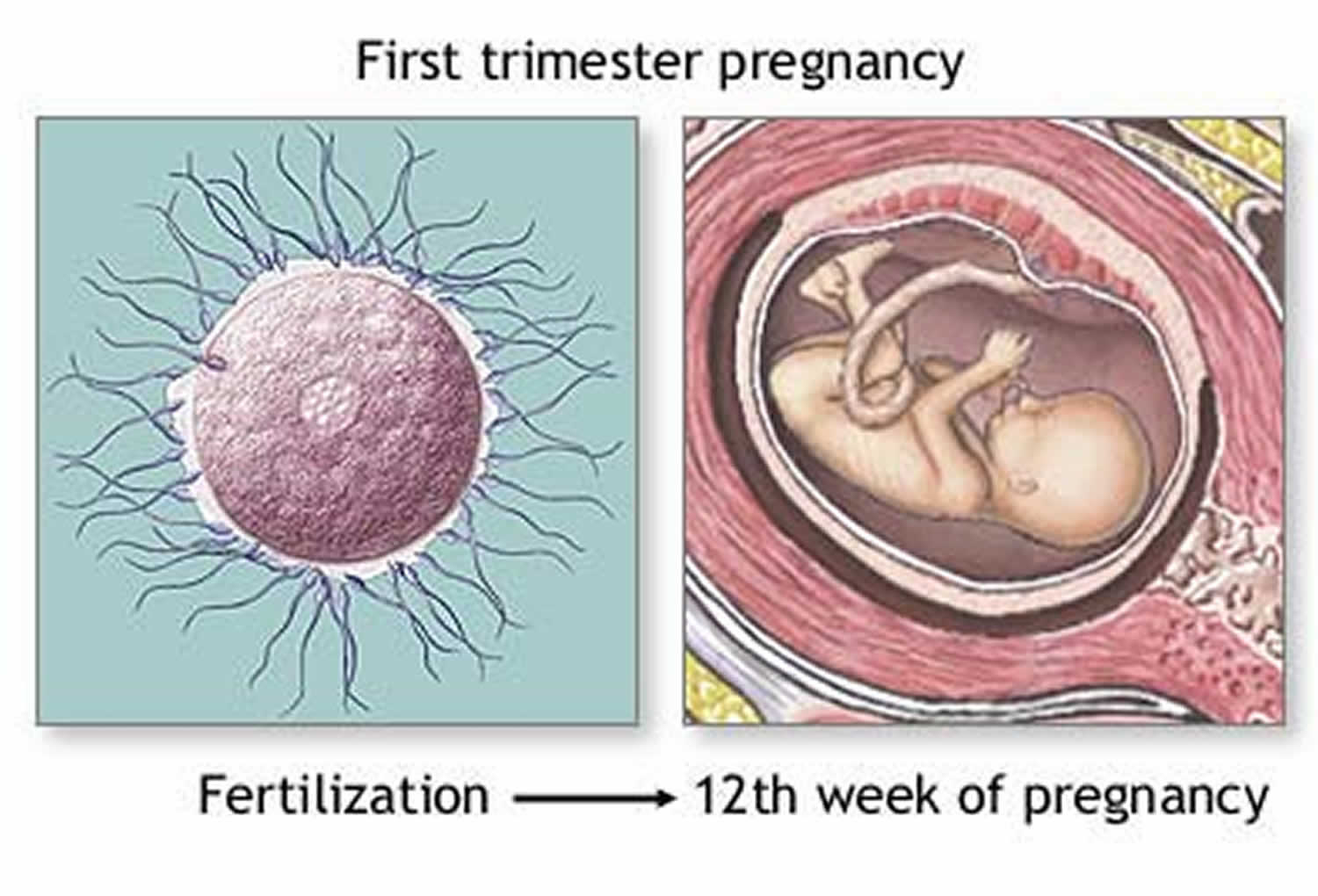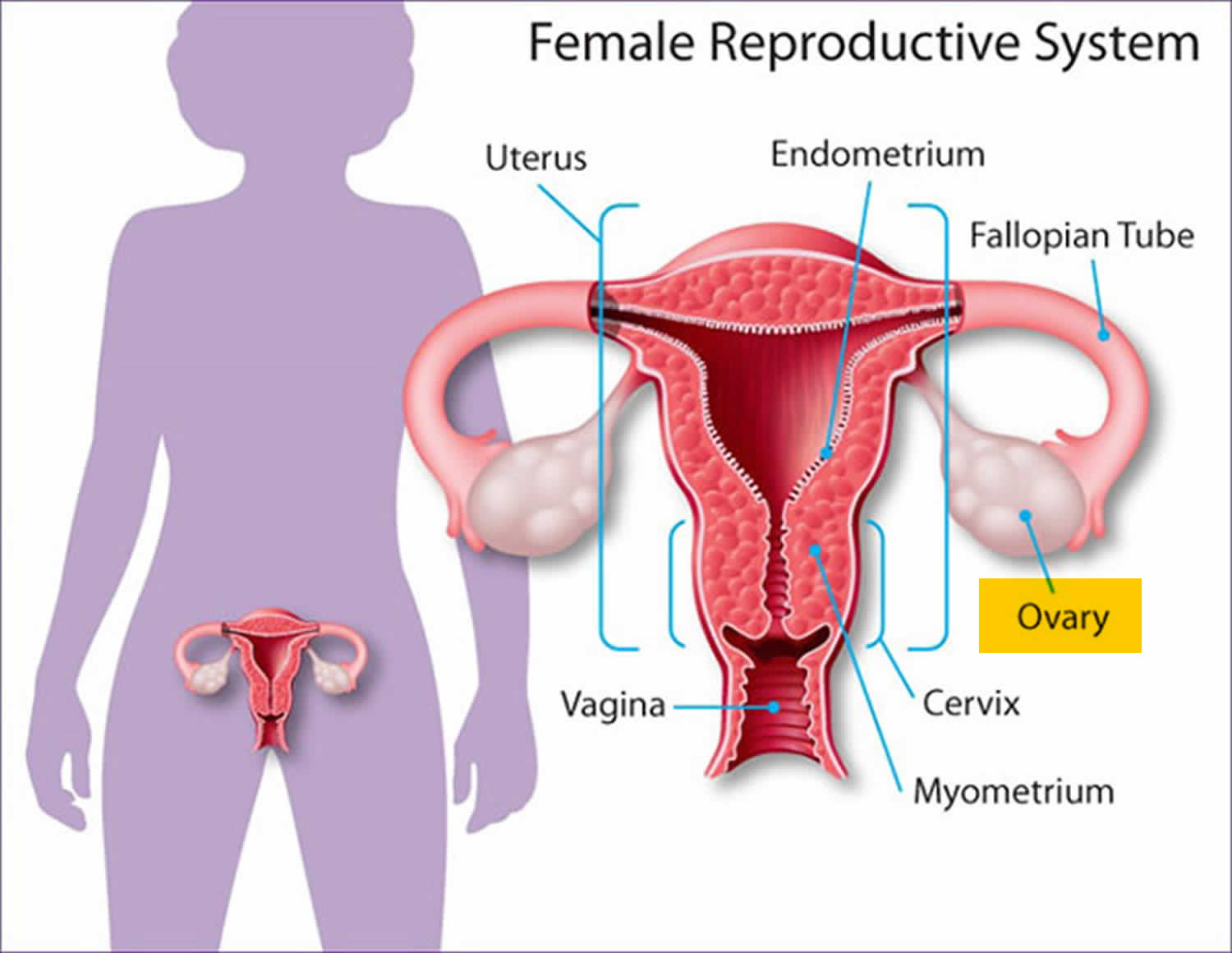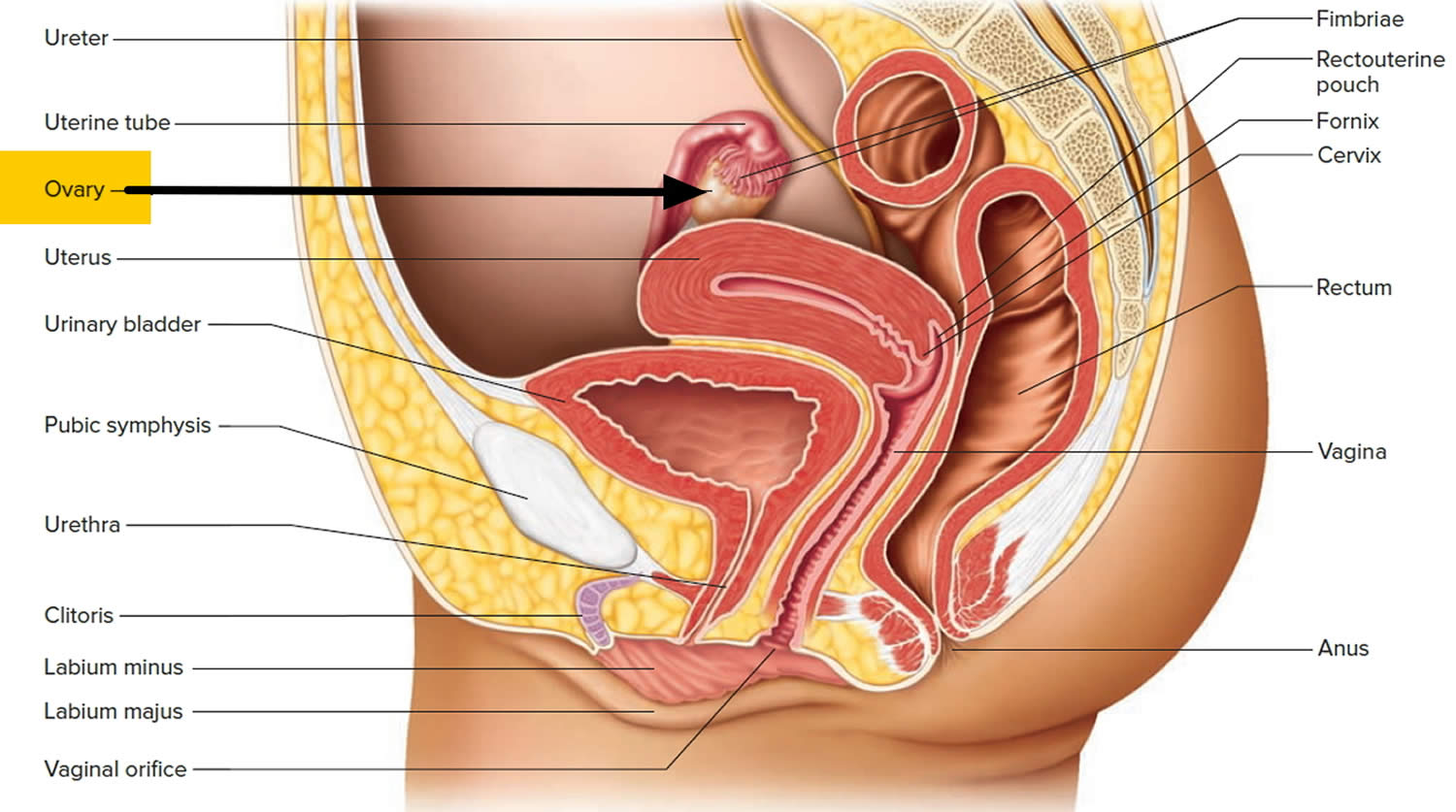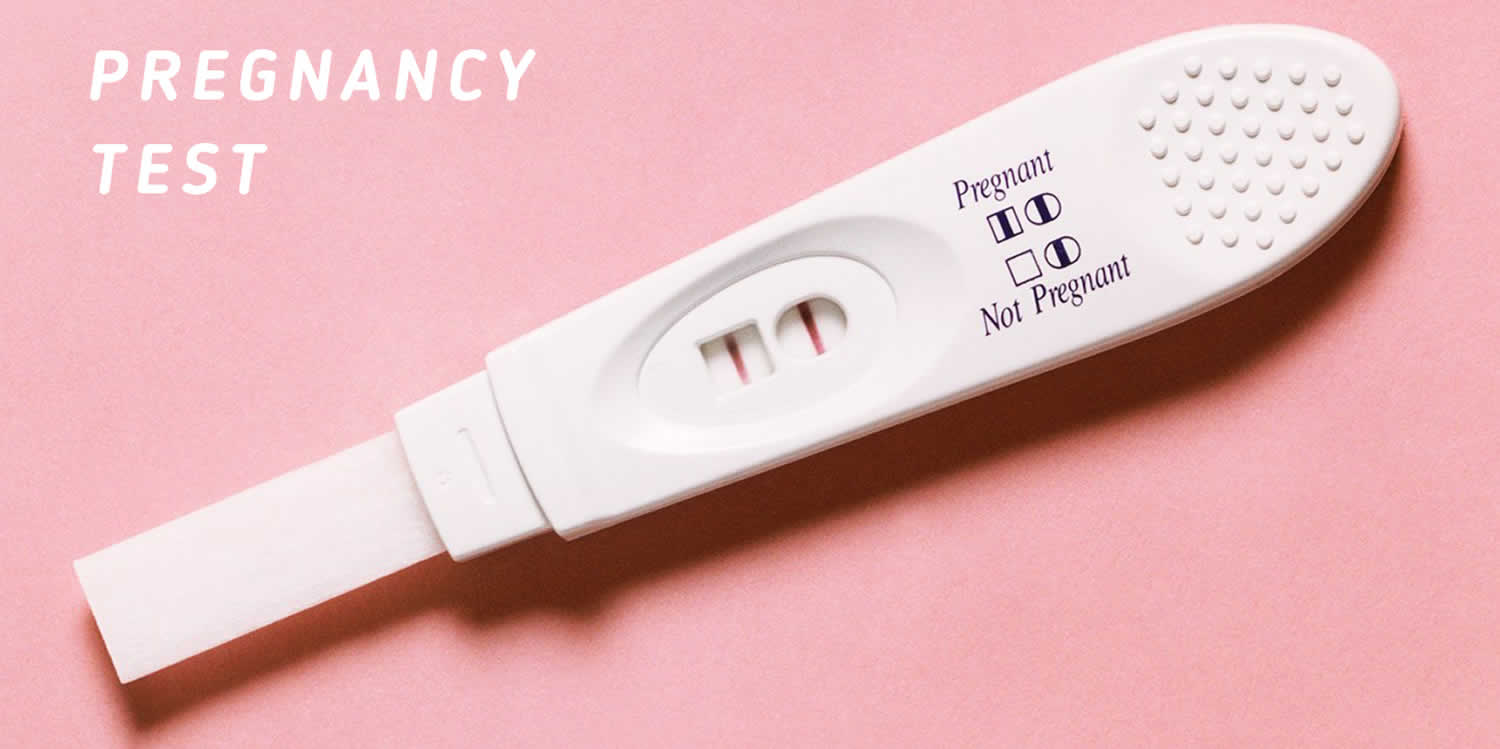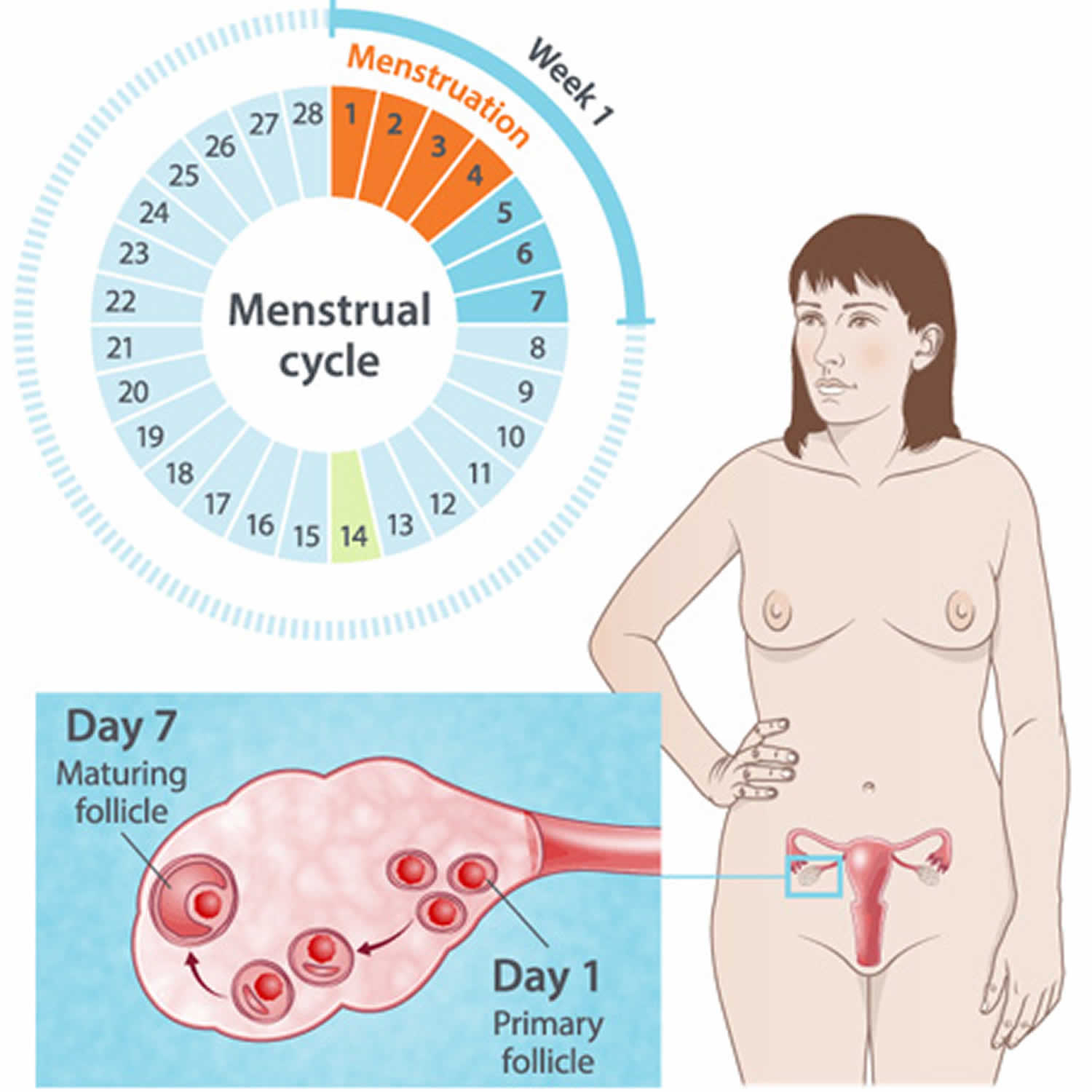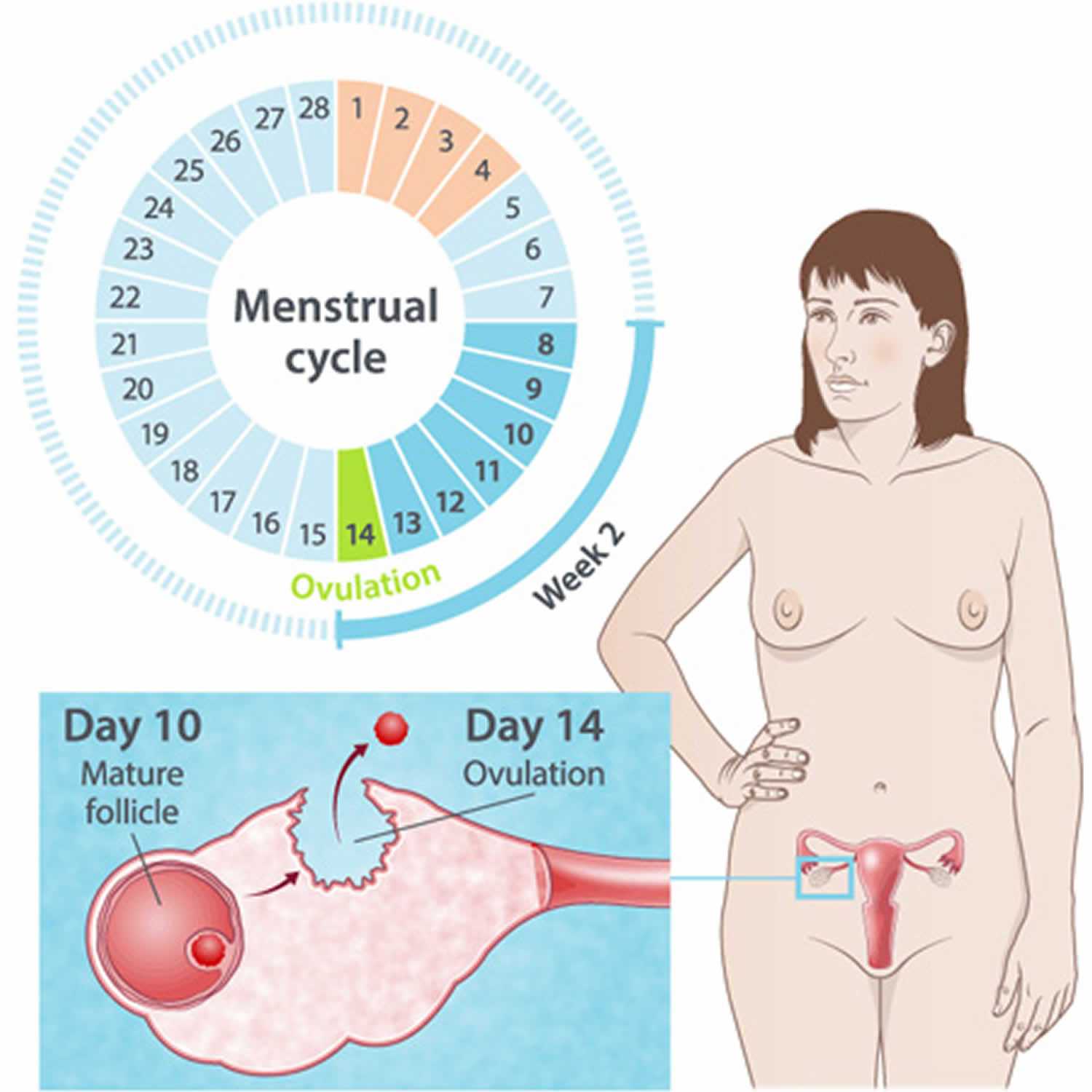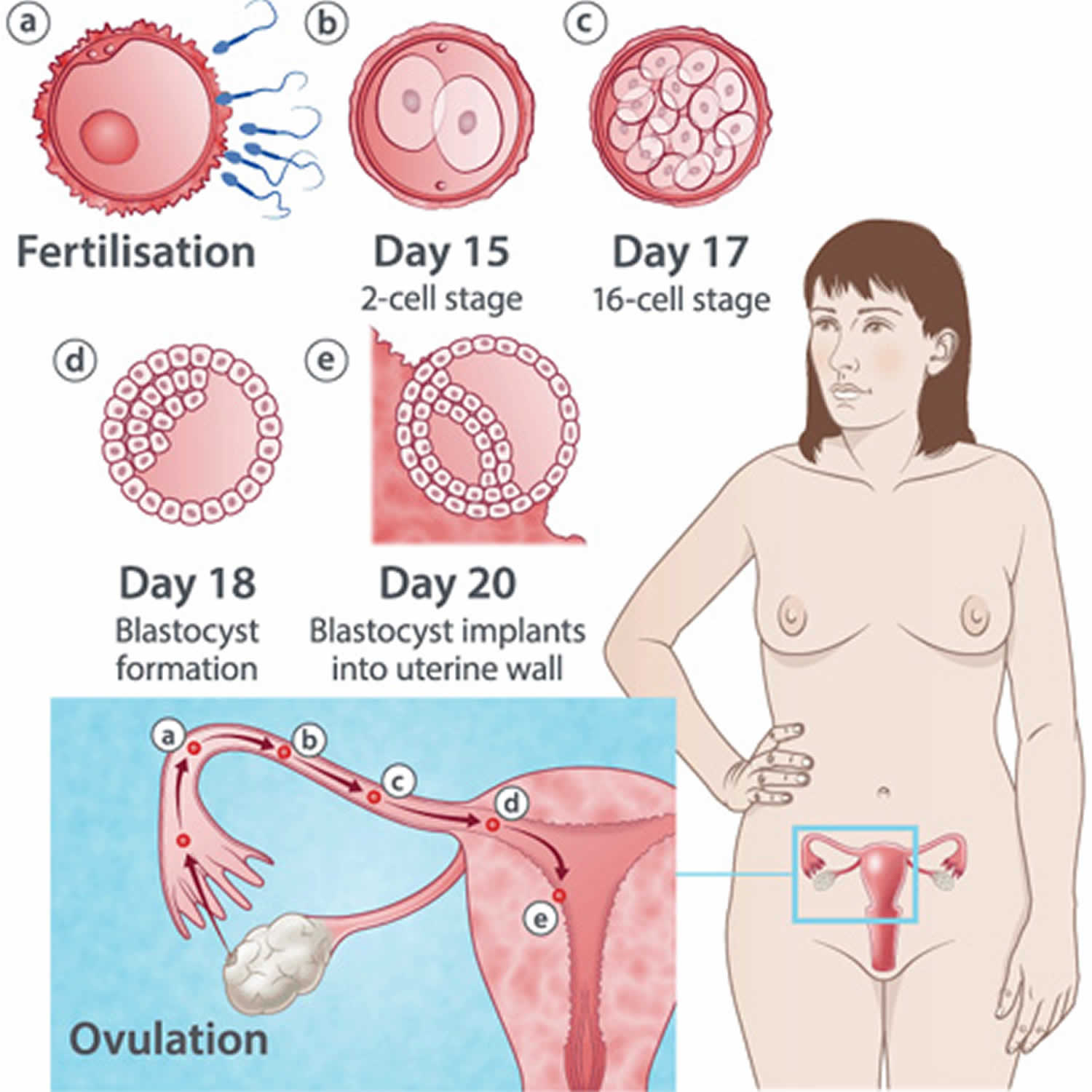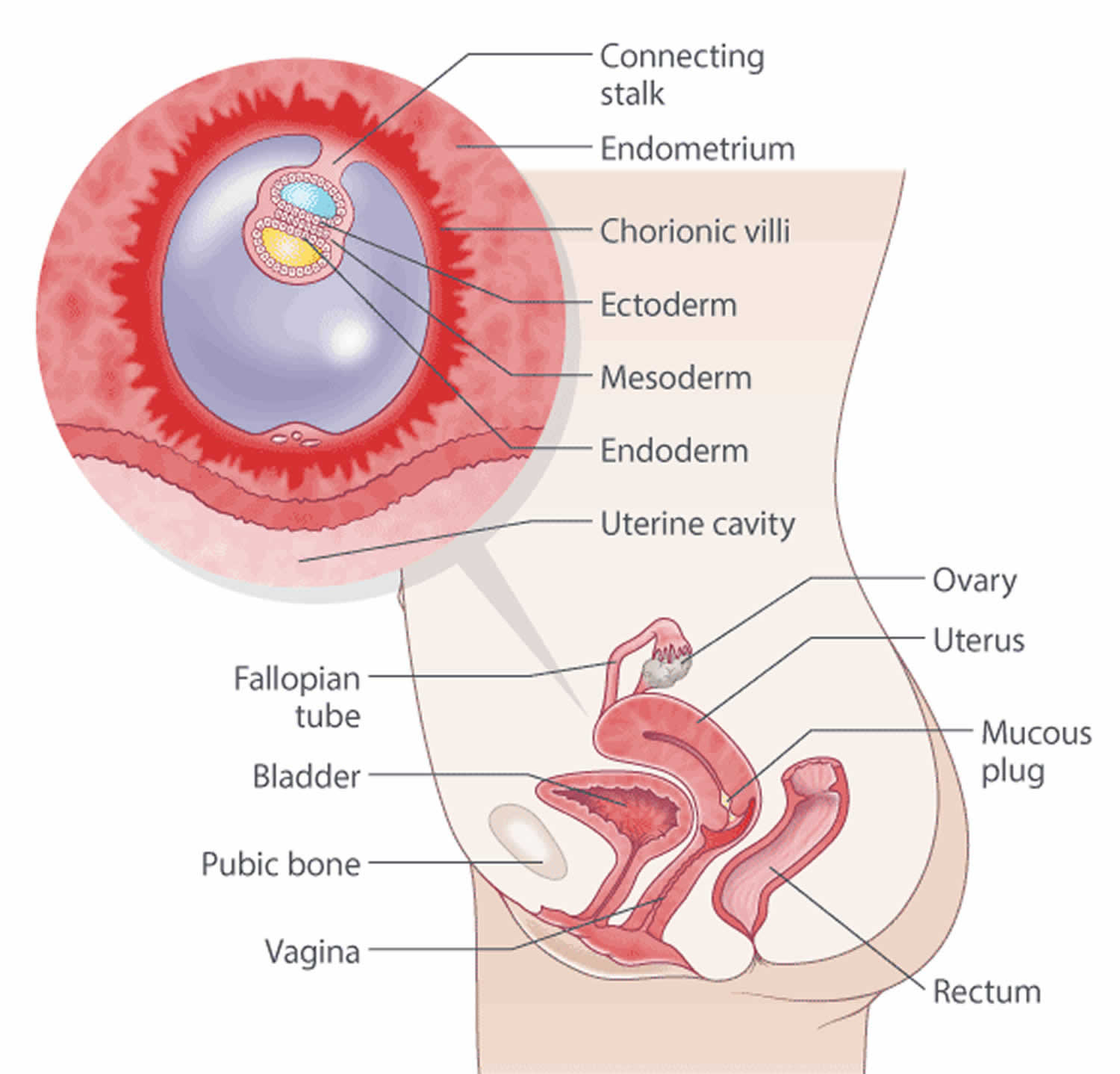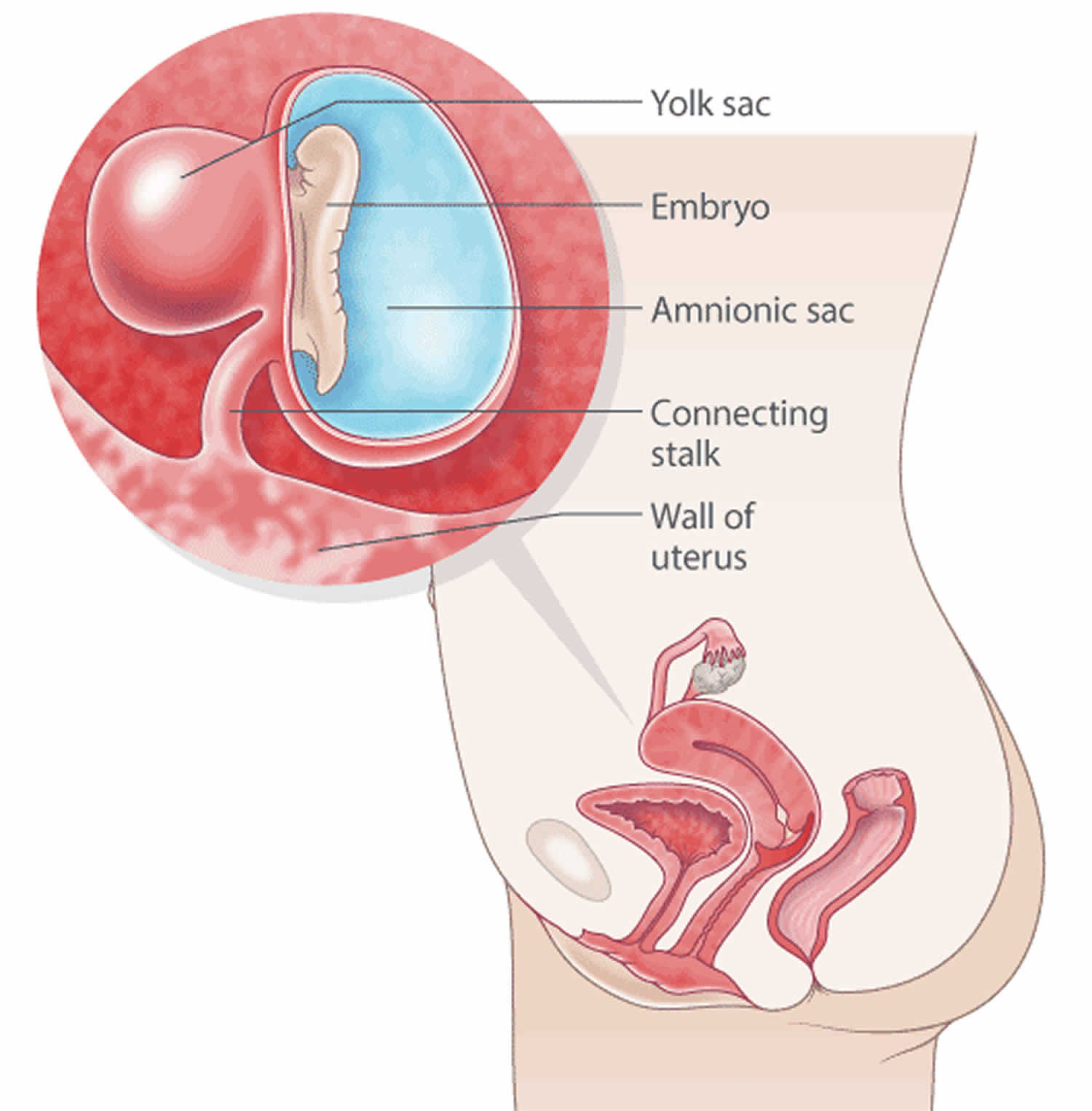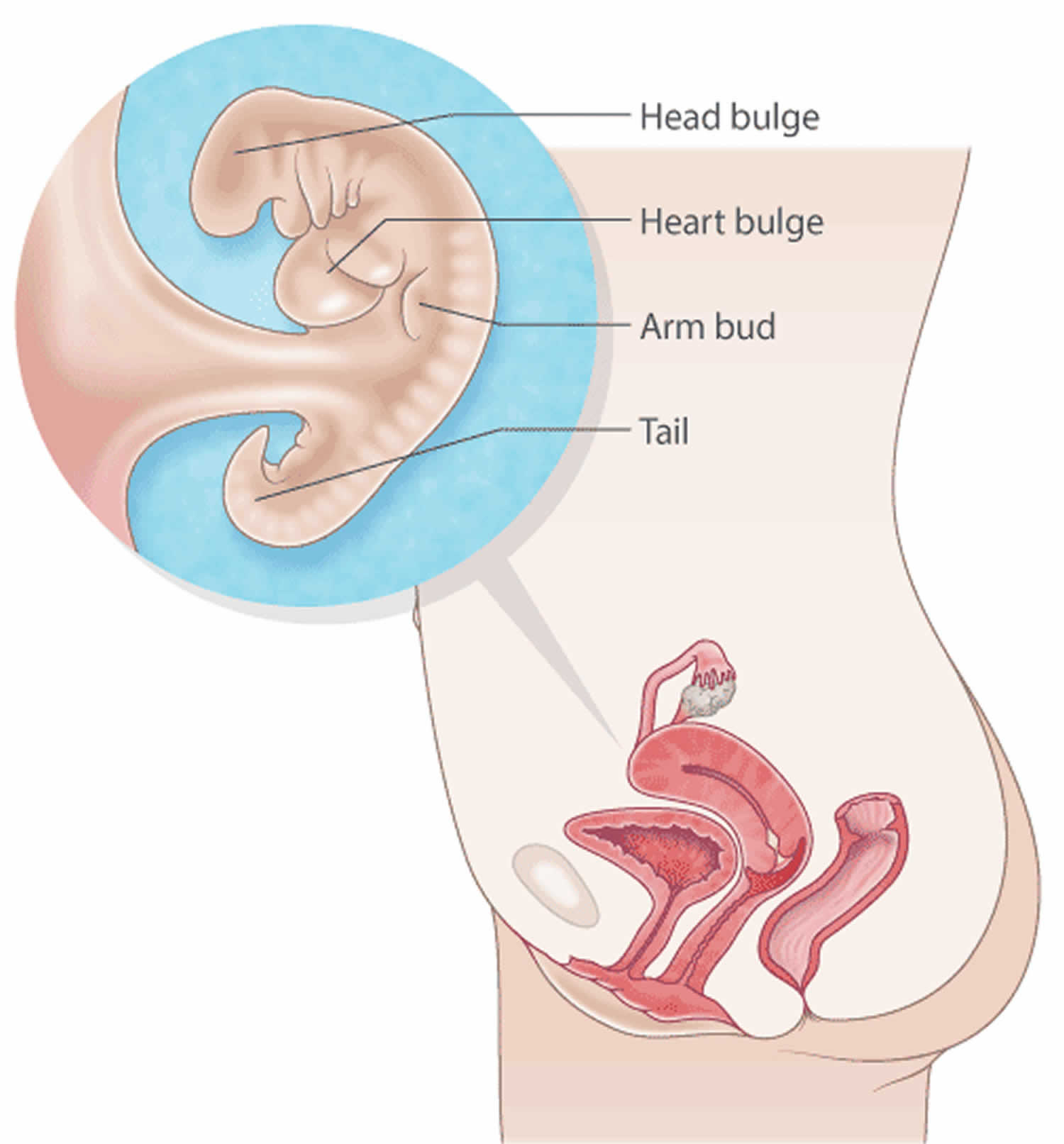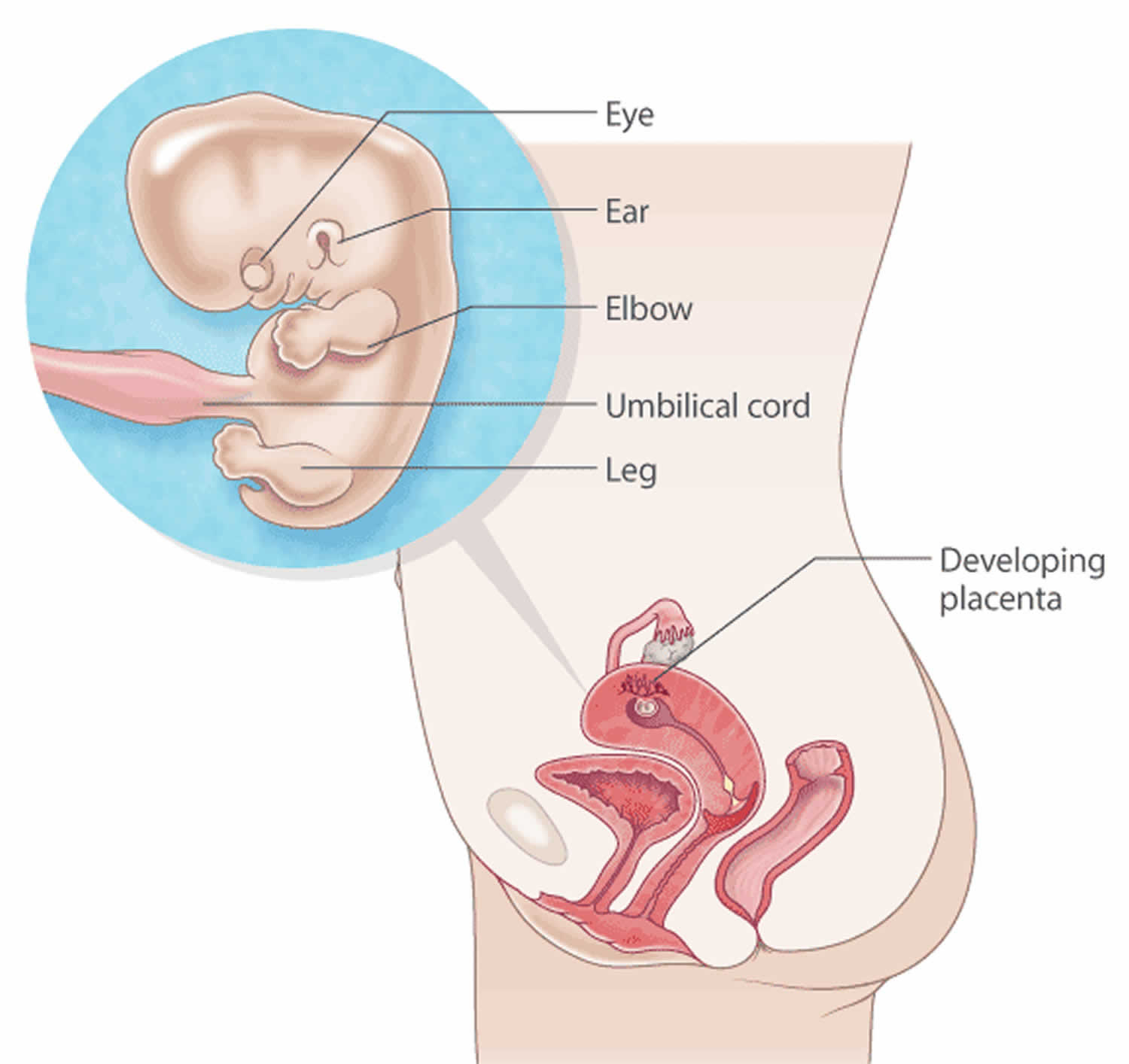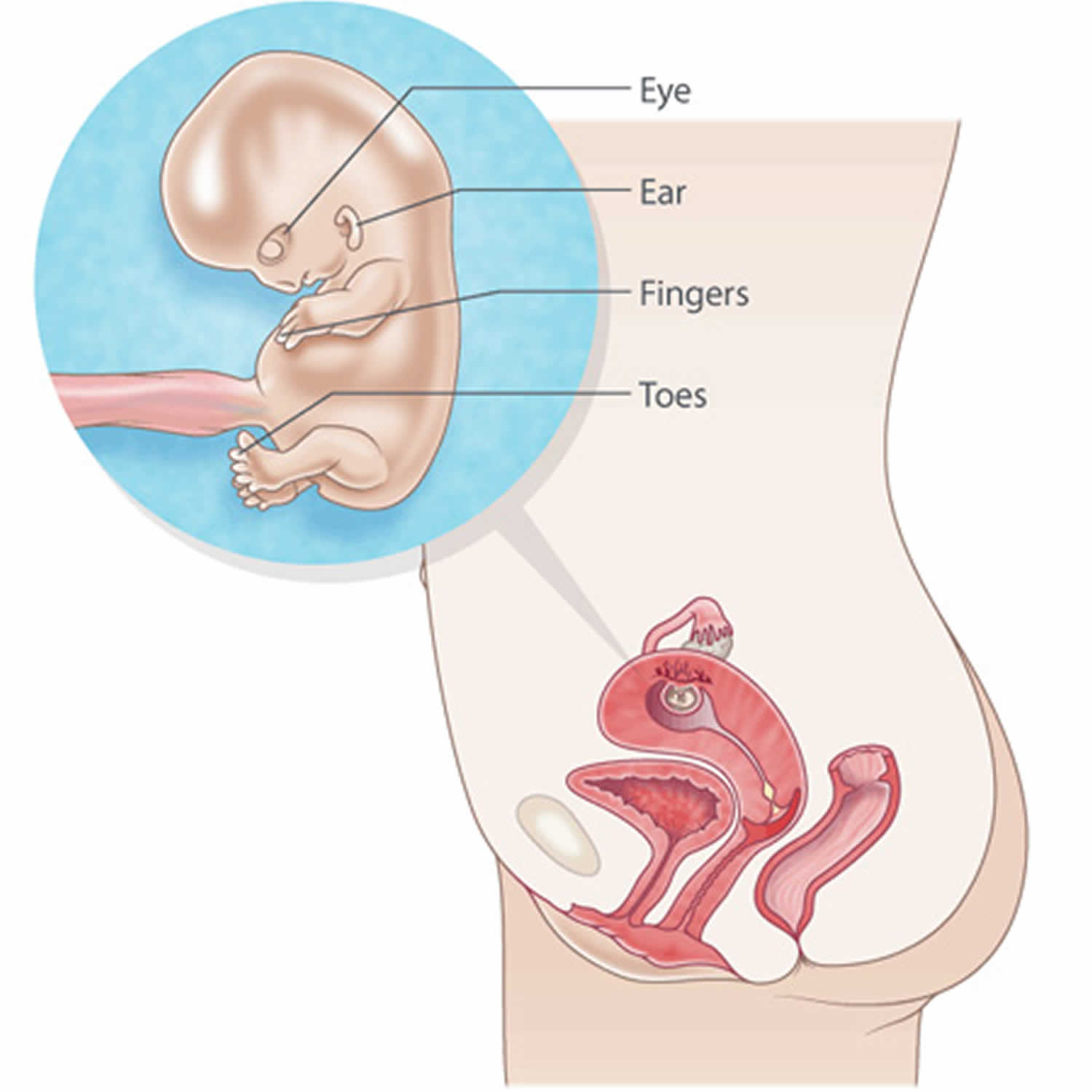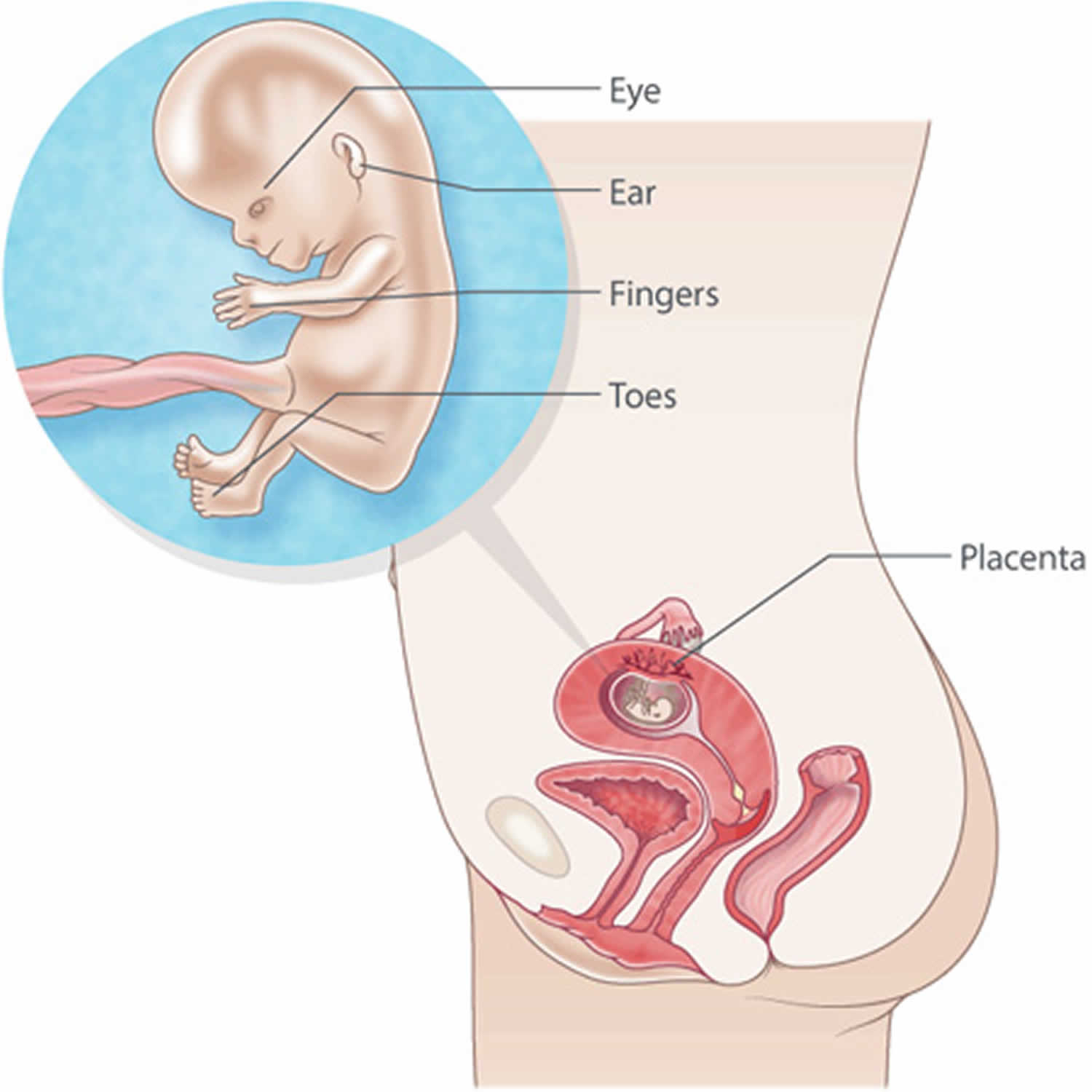First trimester pregnancy
Trimester means 3 months. The first trimester of pregnancy is defined as the first three months (the first 12 weeks) of pregnancy after conception. Pregnancy is dated from the first day of your last period. For around the first 15 days your body will be going through its normal routine – thickening the womb (uterus) and releasing an egg or two. You’re not technically pregnant then. But around week 2 or 3, if an egg meets sperm and fertilization occurs. The fertilized egg (zygote) then travels down your fallopian tube, dividing and redividing, until it reaches your womb. It will then bury itself into the wall (implantation) where your little baby will make itself very comfy for the next nine months. At four weeks, your egg is now an embryo and you are pregnant!
A normal pregnancy is around 9 months and has 3 trimesters:
- First trimester (week 1–week 12)
- Second trimester (week 13–week 28)
- Third trimester (week 29–week 40)
Signs of early pregnancy are missed menstrual periods, fatigue, breast enlargement, abdominal distention, and nausea. During the first trimester of pregnancy all fetal organ development takes place, so the fetus is most susceptible to damage from toxins, drugs, and infections.
During your first trimester, you probably don’t look pregnant at all. Most first-time mums don’t start showing signs of pregnancy until at least week 12. However, if this isn’t your first baby, then you may start showing sooner, as the muscles in your uterus (womb) and belly may have been stretched from your last pregnancy.
Once you know you are pregnant, your doctor or midwife will help you work out when your baby is due also known as the ‘estimated date of confinement’ (EDC) or ‘estimated date of delivery’ (EDD). This is done by adding 40 weeks to the date of the beginning of your last normal menstrual period (LMP). Most pregnancies last around 40 weeks or 38 weeks from conception, so typically the best way to estimate your due date is to count 40 weeks or 280 days, from the first day of your last menstrual period (LMP).
In order to calculate your baby’s due date, add seven days to the date of your last period and then add nine months. For example, if your last period started on 1 March, adding seven days will make that 8 March. Then adding nine months will give a due date of 8 December. If your periods are irregular or you are unsure of the date, an ultrasound will help determine the development of the embryo and your due date. Ultrasound scans can be done at any stage of pregnancy after the first six weeks.
Or another way to do it is to subtract three months from the first day of your last period and add seven days. So if your last period started on April 11, you’d count back three months to January 11 and then add seven days, which means your due date would be January 18.
This is how your doctor will estimate your due date and it’s a pretty accurate target. But remember: It’s just as normal to deliver a week or two before or after your due date, so a full-term pregnancy can be anywhere between 37 and 42 weeks. A baby born before 37 weeks is considered to be premature and anything past 42 weeks is considered overdue.
Due dates are usually calculated on your last period instead of the date of conception because of a number of reasons:
- Although the average woman ovulates (releases an egg) approximately 2 weeks after her period, the exact time is not always known.
- Once an egg has been released, it can remain fertile for up to 24 hours.
- Sperm can last for up to 7 days after intercourse to fertilize an egg.
Some doctors will refer to your due date as ‘expected date of confinement’ (EDC).
Note that calculating your due date based on the first day of your last normal menstrual period (LMP) works well for women who have a relatively regular menstrual cycle. But if your menstrual cycle is irregular, the LMP method may not work for you.
Calculating your due date based on the first day of your last period works well for women who have a relatively regular menstrual cycle. But if your cycle is irregular, the last normal menstrual period (LMP) method may not work for you. Because a reliable estimated date of delivery (EDD) is important, you and your doctor can use your conception date instead if you remember it. Just add 266 days to get your estimated due date.
Ultrasound scan
Even if you can’t pinpoint when you conceived, forget the day of your last menstrual period (LMP) or aren’t sure when your ovulation occurred, other clues can help you and your doctor determine your due date at your first prenatal appointment, including:
- An early ultrasound, which can more accurately date the pregnancy. Just be aware, however, that not all women get an early ultrasound. Some doctors perform them routinely, but others only recommend one if your periods are irregular, you’re 35 or older, you have a history of miscarriages or pregnancy complications or the due date can’t be determined based on your physical exam and LMP.
- Pregnancy milestones such as the first time the baby’s heartbeat is heard (around week 9 or 10, though it can vary) and when you first feel fetal movement (on average between 18 and 22 weeks, but it can be earlier or later), can give clues as to whether your due date is accurate.
- Your fundal height, which is the measurement from your pubic bone to the top of your uterus, is checked by your practitioner at each prenatal visit and helps confirm your due date.
The size of your uterus, which will be noted when your initial internal pregnancy exam is performed, can also be a factor in pinpointing the estimated date of delivery.
Figure 1. Female reproductive organs
Pregnancy key points
- If you think you’re pregnant, see your doctor straight away to start your pregnancy care. Your doctor will:
- confirm that you’re pregnant
- organize routine tests, including a blood test
- check your health
- talk with you about pregnancy care options
- refer you to the health professionals you want to care for you or the place you want to give birth.
- It’s important to go to your antenatal appointments right from the start, so your doctor or midwife can check how you and your baby are going. This includes following your baby’s growth and watching you both for any health problems or risks. Antenatal appointments are also a chance to make decisions about things like tests in pregnancy. Some of these appointments and tests need to happen at particular times.
- Regular exercise, healthy eating and side sleeping during pregnancy are good for you and your baby.
- Physical activity in pregnancy. Being physically active while you’re pregnant is good for you and your baby. It can help you be at a healthy weight, keep strong for birth, and reduce stress. If you’re healthy with an uncomplicated pregnancy, you can probably start or keep going with light to moderate exercise during pregnancy – but check with your midwife or doctor first. Brisk walking or swimming are good options. Aim for around 30 minutes, for most days of the week.
- Daily pelvic floor exercises: Daily pelvic floor exercises will help to prevent urinary problems like incontinence later in pregnancy or after birth. Pelvic floor exercises might also help with your labor and recovery after birth.
- Sleep in pregnancy: The safest sleeping position for pregnancy is on your side, because this position reduces the risk of stillbirth. This is especially important in the third trimester. It’s best to sleep on your left side when you can. Sleeping on your left side can increase the flow of blood and nutrients to your baby. To sleep comfortably on your side, try putting a pillow between your legs and another behind your back. This can ease and prevent back pain. It’s OK if you wake up during the night on your back. Just roll over to sleep on your side.
- Healthy eating in pregnancy: Healthy eating helps you feel good and gives your baby the nutrients he needs to grow.
- Eat plenty of vegetables, fruit and wholegrain breads and cereals for a wide range of vitamins, minerals and fiber.
- Choose low-fat dairy food (or alternatives like soy, rice or oat milk products) for calcium, protein and iodine
- Eat lean red meat for iron and protein, and oily fish like sardines for omega-3 fatty acids and protein.
- Try to choose small, healthy snacks that are low in sugar and fat.
- Foods to avoid in pregnancy: For your health and your baby’s health, it’s best to avoid ready-to-eat chilled foods (like coleslaw and other deli salads), soft cheeses, raw eggs and raw seafood. It’s also good to avoid drinking too much coffee and tea, and too many energy drinks and other drinks with caffeine.
- Smoking, alcohol and other drugs in pregnancy. If you’re taking prescribed drugs, check with your doctor that these are safe to take during pregnancy. Your doctor and midwife will advise you to stop smoking, drinking alcohol and stop taking non-prescribed drugs. Try to stay away from people who are smoking.
- Expect emotional and physical changes in pregnancy, including tender breasts, thicker hair and morning sickness.
- If you need support, talk to your doctor, midwife or a counselor.
Menstrual cycle
The menstrual cycle is the monthly process in which female hormones stimulate an ovary to release an egg, thicken the lining of the uterus to support a pregnancy, and then cause the uterus to shed this lining (through menstruation) if there is no pregnancy. The average menstrual cycle is 28 days, but this varies between women and from month to month. In teens, the menstrual cycle can range from 21 to 45 days, but for most women, it is 21 to 35 days 1.
The menstrual cycle is characterized by regular, recurring changes in the endometrium, which culminate in menstrual bleeding (menses). Such cycles usually begin around age thirteen and continue into the early fifties, then cease.
A female’s first menstrual cycle, called menarche, occurs after the ovaries and other organs of the reproductive control system mature and begin responding to certain hormones. Then, the hypothalamic secretion of gonadotropin-releasing hormone (GnRH) stimulates the anterior pituitary to release threshold levels of follicle-stimulating hormone (FSH) and luteinizing hormone (LH). Follicle-stimulating hormone (FSH) stimulates the final maturation of an ovarian follicle. The follicular cells produce increasing amounts of estrogens and some progesterone. Luteinizing hormone (LH) stimulates certain ovarian cells to secrete precursor molecules (such as testosterone), also used to produce estrogens.
In a young female, estrogens stimulate the development of secondary sex characteristics. Estrogens secreted during subsequent menstrual cycles continue the development and maintenance of these characteristics.
Figure 2. Menstrual cycle
Can I plan my due date?
Whether you’re trying to avoid being very pregnant in the middle of summer or are a teacher who wants to maximize time off with your little one, you can try to time when you conceive in order to “plan” your due date.
But even if you’re one of the lucky ones who’s able to get pregnant when she really wants to, just remember that you probably won’t be able to map out exactly when you’ll give birth to the day or even the week or month.
Can my due date change?
Yes, your estimated due date can change. While it’s definitely not a reason to worry, your doctor may change your due date for a number of reasons as your pregnancy progresses.
It may be that your periods are irregular and your early ultrasound dating was off or that your first ultrasound was in the second trimester.
It could also be because your fundal height is abnormal or your levels of alpha-fetoprotein (AFP), a protein made by the baby, are outside the usual range. Talk to your doctor if you have any questions or concerns.
How does pregnancy happen?
Each month your ovaries release an egg about 14 days before the first day of your period. This is called ovulation. When you and your partner have unprotected sex around the time of ovulation, his sperm swim to meet your egg. Unprotected sex means you don’t use any kind of birth control to help prevent pregnancy.
When the egg and sperm meet, it’s called fertilization. The fertilized egg (also called an embryo) moves through your fallopian tubes and attaches to the wall of your uterus where it grows and develops into a baby. When the embryo attaches to the uterus, it’s called implantation.
You can get pregnant if you have unprotected sex any time from 5 days before and the day of ovulation. The more often you have sex during this time, the more likely you are to get pregnant. Your egg is fertile (can become an embryo) for 12 to 24 hours after ovulation. Your partner’s sperm can live inside you for up to 72 hours after you have sex.
How long does it usually take to get pregnant?
It’s impossible to say how long it takes to get pregnant because it’s different for each woman.
Many factors can affect a couple’s chances of conceiving, such as:
- your age
- your general health
- your reproductive health
- how often you have sex
Some women become pregnant quickly, while others take longer. This may be upsetting, but it’s normal.
Fertility
Most couples (about 84 out of every 100) will get pregnant within a year if they have regular sex and don’t use contraception. However, women become less fertile as they get older. One study found that among couples having regular unprotected sex:
- aged 19-26 – 92% will conceive after one year and 98% after two years
- aged 35-39 – 82% will conceive after one year and 90% after two years
The effect of age on men’s fertility is less clear.
What does ‘have regular sex’ mean?
Having regular sex means having sex every two to three days throughout the month.
Some couples may try to time having sex with when the woman ovulates (releases an egg). However, guidance from the National Institute for Health and Care Excellence advises that this can be stressful and is not recommended.
Fertility problems
Fertility problems affect ten to 15 percent of couples in the United States.
Lots of factors can cause fertility problems, including:
- hormonal (endocrine) disorders, such as polycystic ovary syndrome (PCOS) and problems with the thyroid or pituitary glands
- physical disorders such as obesity, anorexia nervosa or excessive exercise
- disorders of the reproductive system, such as infections, blocked fallopian tubes, endometriosis or a low sperm count
Some of these factors affect either women or men. In around 40% of infertile couples, there is a problem with both the man and woman.
The most common cause is ovulation failure (which can be caused by lots of different things) and sperm disorders. In 25% of couples, fertility problems cannot be explained.
How do I know if I’m pregnant?
You may be pregnant if:
- You miss your period.
- Your breasts are big and sore. The area around your nipples gets darker.
- You have to urinate (pee) a lot.
- You feel sick to your stomach or throw up.
- You feel tired all the time.
- You feel moody.
- You feel bloated. This means your body feels full or like it’s swollen.
If you have any of these signs and symptoms and you think you may be pregnant, there are home urine pregnancy tests that can be bought over the counter to check your human chorionic gonadotrophin (hCG) levels which may indicate you are pregnant. It is always important to see your doctor to confirm whether you’re pregnant, work out your due date and what foods you should be eating.
Once your pregnancy is confirmed, you should start thinking about the type of care you want throughout your pregnancy and the birth. If you are in the workforce this is also the time to find out about your rights at work and about maternity leave.
There are several ways to find out if you are pregnant.
Your doctor can give you a blood test and a physical exam to confirm that you’re pregnant. Home pregnancy tests can give you a false-positive result — this means the test says you’re pregnant but you’re really not. This is why it’s a good idea to see your doctor to make sure you really are pregnant.
Pregnancy urine tests
You can buy home pregnancy urine testing kits from your local pharmacy. The tests check for the pregnancy hormone, human chorionic gonadotrophin (hCG).
With home pregnancy tests:
- Make sure you follow the instructions on the test very carefully to get the most accurate result.
- Wait until at least a week after your expected period before testing to get the most reliable result.
- If you are taking fertility drugs or you are an older woman, you may get a false result.
- If you use a home pregnancy kit, always see a doctor to confirm the pregnancy.
You can also have a urine test done at a hospital clinic by your doctor, or at a family planning clinic.
Figure 3. Home pregnancy urine test
Pregnancy blood test
A blood test will give you a reliable result, even at the earliest stage of pregnancy. Your doctor will order the test, which will check for the human chorionic gonadotrophin hormone in your blood. You can have this test done as soon as you have missed your period.
Internal examination
At least 2 weeks after your missed period, your doctor may examine you internally to check for changes in your uterus and cervix (the lowest part of your uterus). When you are pregnant, your doctor will be able to tell that your cervix has changed color and is softer. Your uterus is already getting bigger in the first few weeks of pregnancy. Most doctors will still do a blood or urine test to confirm your pregnancy.
How soon can I take a pregnancy test?
All pregnancy tests detect the hormone human chorionic gonadotrophin (hCG), which starts to be produced around six days after fertilization. When you suspect that you are pregnant, pregnancy tests are can be done reliably from the first day up to 10 days of your missed menstrual period, although some tests can detect human chorionic gonadotropin (hCG) as early as four or five days before your menstrual period is due. A urine sample collected first thing in the morning or a blood sample drawn from a vein in your arm is usually done to detect early pregnancy.
Check the packaging of your home pregnancy test kit to find out when it can be used.
If you have regular periods, you’ll probably know when your next period is due. If you’re not sure, it’s a good idea to wait at least three weeks after you think you may have conceived before doing a pregnancy test.
Pregnancy Test Preparation Needed
No test preparation is needed. However, do not drink large amounts of fluid before collecting a morning urine sample for a pregnancy test because overly diluted urine may result in a false negative; however, no preparation is needed if you’re having a pregnancy test through a blood sample drawn from a vein in your arm. A false negative pregnancy test means the test result inappropriately indicating negative pregnancy result when, in fact, you’re pregnant.
How accurate are home pregnancy tests?
Most home pregnancy tests claim to be up to 99% accurate. But the accuracy depends on:
- How you use them. Be sure to check the expiration date and follow the instructions. Wait up to 10 minutes after taking the test to check the results window. Research suggests that waiting 10 minutes will give the most accurate result.
- When you use them. The amount of human chorionic gonadotropin (hCG) or pregnancy hormone in your urine increases with time. The earlier you take the test, the harder it is for the test to detect the hCG. Most home pregnancy tests can accurately detect pregnancy after a missed period. Also, testing your urine first thing in the morning can boost the accuracy.
- Who uses them. Each woman ovulates at a different time in her menstrual cycle. Plus, the fertilized egg can implant in a woman’s uterus at different times. Your body makes human chorionic gonadotropin (hCG) after implantation occurs. In up to 10% of women, implantation does not occur until after the first day of a missed period. This means home pregnancy tests can be accurate as soon as 1 day after a missed period for some women but not for others.
- The brand of the home pregnancy test kit. Some home pregnancy tests are more sensitive than others. For that reason, some tests are better than others at detecting human chorionic gonadotropin (hCG) early on. Talk to your pharmacist about which brand may be best for you.
What should I consider when buying a pregnancy test?
Make sure that the pregnancy test you are purchasing is U.S. Food and Drug Administration (FDA)-approved.
The FDA requires manufacturers to meet stringent controls for quality, precision, and accuracy. Approved pregnancy test tests must also meet U.S. Food and Drug Administration (FDA) labeling requirements.
- For all over-the-counter (OTC) U.S. Food and Drug Administration (FDA) approved home pregnancy test kits, please go here to find details about each product: https://www.accessdata.fda.gov/scripts/cdrh/cfdocs/cfIVD/Search.cfm
According to the U.S. Food and Drug Administration (FDA) 2, the accuracy of home pregnancy test depends on how well you follow the instructions and interpret the results. “If you mishandle or misunderstand the home pregnancy test kit, you may get poor results. Most pregnancy tests have about the same ability to detect hCG, but their ability to show whether or not you are pregnant depends on how much hCG you are producing. If you test too early in your cycle or too close to the time you became pregnant, your placenta may not have had enough time to produce hCG. This would mean that you are pregnant but you got a negative test result. Because many women have irregular periods, and women may miscalculate when their period is due, 10 to 20 pregnant women out of every 100 will not detect their pregnancy on the first day of their missed period”.
Other things to consider when buying a home pregnancy test kit:
- Cost. Home pregnancy tests come in many different types. Most stores sell them over the counter (without a doctor’s prescription). The cost varies depending on the brand and how many tests come in the box.
- Accuracy. Most tests can be taken as soon as you miss your period. Some newer, more expensive tests say they can be used 4 or 5 days before your period. Even so, they claim the best accuracy only after the date of your expected period.
When should I take a home pregnancy test?
Many home pregnancy tests claim to be accurate as early as the first day of a missed period — or even before. You’re likely to get more accurate results, however, if you wait until after the first day of your missed period or, better yet, one week after your missed period.
Why wait?
Shortly after a fertilized egg attaches to your uterine lining (implantation), the placenta forms and produces the hormone human chorionic gonadotropin (HCG). This hormone enters your bloodstream and urine. During early pregnancy, the human chorionic gonadotropin (hCG) concentration increases rapidly — doubling every two to three days. The earlier you take the home pregnancy test, the harder it might be for the test to detect human chorionic gonadotropin (hCG). Keep in mind that the exact timing of ovulation might vary among women or even from month to month, and the fertilized egg can implant in the uterus at different times. This can affect when human chorionic gonadotropin (hCG) production begins and becomes detectable.
If it’s important to confirm your pregnancy right away, depending on how far along you are in your pregnancy, your health care provider might recommend that you have an ultrasound, repeat a urine test in the hospital or clinic lab, or have a blood test to measure your human chorionic gonadotropin (hCG).
When can I take a pregnancy test?
You can carry out most pregnancy tests from the first day of a missed menstrual period. If you don’t know when your next menstrual period is due, do the test at least 21 days after you last had unprotected sex.
Some very sensitive pregnancy tests can be used even before you miss a period, from as early as eight days after conception.
You can do a pregnancy test on a sample of urine collected at any time of the day. It doesn’t have to be in the morning. However, you can improve your chances for an accurate result by using your first morning urine for the pregnancy test, because it will have more human chorionic gonadotropin (hCG) in it than in urines collected later in the day. Make sure you carefully follow the home pregnancy test kit directions. If the home pregnancy test is negative, it is often repeated several days later. Since human chorionic gonadotropin (hCG) rises rapidly, an initial negative test can turn positive within this time period. Some home pregnancy test kits come with more than one test in them to allow you to repeat the test.
I have irregular periods and don’t know when my next period will start. When should I take a pregnancy test?
Most pregnancy tests claim to be the most accurate after a missed period. But irregular periods can make it hard to predict when to take the test.
Menstrual periods are considered irregular if:
- The number of days between periods is either shorter than 21 days or longer than 35 days
- The number of days in the menstrual cycle varies from month to month. For example, your cycle may be 22 days one month and 33 days the next month.
If you have irregular periods, try counting 36 days from the start of your last menstrual cycle or four weeks from the time you had sex. At this point, if you are pregnant, your levels of human chorionic gonadotropin (hCG) should be high enough to detect the pregnancy.
If your test says you are not pregnant, but you still think you may be pregnant, wait a few more days and take another pregnancy test. Or, see your doctor for a blood test.
What are early signs of pregnancy?
For women who have a regular monthly menstrual cycle, the earliest and most reliable sign of pregnancy is a missed period. Some of the other early pregnancy signs and symptoms are listed below. Every woman is different and not all women will notice all these symptoms.
Missed period
If your period doesn’t arrive as expected, you may be pregnant, but there can be other reasons for a missed period, such as illness, stress and strenuous activity.
Sometimes women who are pregnant have a very light period, losing only a little blood.
Feeling sick and vomiting
You may feel sick and nauseous, and you may vomit. This is commonly known as morning sickness, but it can happen at any time of the day or night. If you’re being sick all the time and can’t keep anything down, contact your doctor.
Feeling very tired
It’s common to feel very tired, or even exhausted, during pregnancy, especially during the first 12 weeks or so. Hormonal changes taking place in your body at this time can make you feel tired, nauseous, emotional and upset.
Changes in your breasts
Your breasts may become larger and feel tender, just as they might do before your period. They may also tingle. The veins may be more visible, and the nipples may darken and stand out.
Bladder changes
You may feel the need to pass urine more often than usual, including during the night. This is caused by pregnancy hormones and usually settles after a few months.
Other signs of pregnancy
Other signs of pregnancy that you might notice are:
- constipation
- an increased vaginal discharge without any soreness or irritation
- a strange taste in your mouth, which many women describe as metallic
- changes in what you want to eat, such as craving new foods and losing interest in certain foods or drinks that you previously enjoyed, such as tea, coffee or fatty food
- losing interest in tobacco if you smoke
- having a more sensitive sense of smell than usual, for example to the smell of food or cooking.
First trimester pregnancy symptoms
Early pregnancy symptoms at 4 weeks
- To start with, you might have no symptoms at all – but then the pregnancy hormone, human chorionic gonadotrophin (hCG) starts to kick in.
During your first trimester you might experience early pregnancy symptoms, such as:
- a missed period (often one of the first signs of pregnancy)
- a metallic taste in your mouth
- sore breasts
- nausea (also known as morning sickness, although it can strike at any time)
- tiredness
- new likes and dislikes – anyone for blueberry muffins with pickle? You can read our advice in week 5
- a heightened sense of smell
- needing to wee more frequently
- a milky white pregnancy discharge from your vagina
- light spotting as the fertilized egg burrows into your uterus (see your doctor if you get bleeding during pregnancy)
- cramping, a bit like period pains
- darkened skin on your face or brown patches – this is known as chloasma faciei or the “mask of pregnancy”
- thicker and shinier hair
- bloating and the feeling of being bloated
If you think you could be pregnant but haven’t noticed any symptoms, you still might be. You could just be lucky. Some women sail through their pregnancy feeling on top of the world. Everyone’s different and nobody else will have a pregnancy just like yours.
1 week pregnant
This week you have your period. Your pregnancy is calculated from the first day of this period. This is because it can be hard – impossible, even – to know exactly when your baby was conceived. But most women can remember the day their period started.
Figure 4. First week pregnant
If you’re hoping to get pregnant, doctors recommend that you:
- Take folic acid for at least three months before the pregnancy and the first three months of your pregnancy. All women and teen girls who could become pregnant should consume 400 mcg of folic acid daily from supplements, fortified foods, or both in addition to the folate they get from following a healthy eating pattern 3.
- Get immunized against rubella – if you’re not already – and avoid getting pregnant for one month after the vaccination
- Speak to a doctor or a genetic counselor if there’s a history of hereditary disease in your family
- Check the safety of any medications you’re taking by talking with your doctor
- Stop drinking alcohol, and avoid drinking too much coffee, tea and others drinks with caffeine in them
- Cut out smoking and non-prescribed drugs
- Eat a healthy, well-balanced diet, full of vitamins and minerals
- Be physically active and talk to your doctor about a healthy weight for pregnancy if you’re overweight
- Have a medical check if you have a chronic health problem like high blood pressure, diabetes or epilepsy.
You might also want to think about practical things like your parental leave entitlements, your family finances, your home, your transport, and how you and your partner – if you have one – plan to organize child care.
Your pregnancy might not have been planned. That’s OK. It’s a very good idea to see your doctor as soon as possible to start planning your pregnancy care.
2 weeks pregnant
Your period has finished by now. One of your ovaries is getting ready to release an egg. The ovaries are also producing lots of oestrogen. Oestrogen kick-starts some important processes in your body:
- Your fallopian tubes and cervix produce ‘fertile mucus’, which helps and protects any sperm along its way.
- A new lining – the endometrium – starts growing in your uterus. A fertilized egg will bury itself in the endometrium.
- By the end of this week, the ovary is ready to release an egg – this is called ovulation.
Ovulation usually happens around day 14 if you have a 28-day menstrual cycle. You’ll be more likely to get pregnant if you have sex 1-3 days before ovulation.
Figure 5. Pregnancy week 2
3 weeks pregnant
The egg (sometimes two, if you’re having fraternal twins) travels down your fallopian tube in the direction of your uterus. If you’ve had sex, sperm are moving upwards through your cervix and uterus.
For conception to occur, a sperm must burrow through the outer layers of the egg to the very middle. This process usually happens in the fallopian tube. If it does happen, you’re pregnant.
Your progesterone levels increase now. This hormone lets your body know you’re pregnant, causing the endometrium to build up its nutrient supply, which stops you from having your period.
Figure 6. Pregnancy week 3
4 weeks pregnant
The fertilized egg moves down your fallopian tube to the uterus, where it implants itself in the endometrium. This can take 3-10 days. Some women have a small amount of bleeding or ‘spotting’ around the time of implantation.
You might not notice any changes in your body such as sore breasts and tiredness, but by the end of the week you’ll probably have missed your period and could be wondering if you’re pregnant.
From the moment of conception, the fertilized egg called a blastocyst, starts dividing itself. By the end of this week, it’s a ball of about 200 cells and is about 4-5 mm across. Inside the ball, three layers are forming:
- The ectoderm – this becomes your baby’s nervous system, brain, hair and skin.
- The endoderm – this becomes the gut and other internal organs.
- The mesoderm – this develops into the skeleton, blood systems and muscles.
The outside of the blastocyst divides into two parts:
- The outside part sends out little tentacles – called chorionic villi – which bury into your endometrium. The chorionic villi develop into the placenta.
- The inside part becomes the amniotic sac – the protective bubble filled with fluid where the embryo develops.
Identical twins
Identical, or monozygotic, twins are conceived when a single sperm fertilizes an egg. At a very early stage in the cell division process, the fertilized egg divides into two and starts forming two babies. Identical twins have the same genes, so they’re the same gender.
Figure 7. Pregnancy week 4
5 weeks pregnant
Now could be a good time to do a home pregnancy test if you’ve missed a period and you’ve been sexually active. Pregnancy tests measure the amount of a hormone called human chorionic gonadotropin (HCG). Different kits show results in different ways, so read and follow the instructions carefully.
A positive pregnancy test
For many women, pregnancy is something to celebrate. For some women, it might come as a complete surprise or shock. Even if you’ve been planning to have a baby, finding out that you’re pregnant can bring some mixed emotions or uncertainty about what lies ahead.
Your pregnancy experience can be affected by other things going on in your life, such as:
- whether your pregnancy was planned
- whether you have a partner
- how much help you expect to have with raising your child
- how long it took you to get pregnant
- whether you’ve had any pregnancy losses such as miscarriage or stillbirth in the past
- whether you’ve had medical assistance, such as IVF
- whether you’re in a stable relationship
- whether you’ve felt pressure from your partner or family to get pregnant.
Signs of early pregnancy
This week you might be experiencing some signs of early pregnancy, including:
- more tired than usual
- wanting to go to the toilet more often – especially at night
- nauseous, or even vomiting
- feeling some tenderness in your breasts.
Every woman is different when it comes to morning sickness. Some women don’t get it at all, and some get it all day. A few (about 1%) get it so severely they can’t keep any food or fluids down. This is called hyperemesis gravidarum. If you’re having very severe symptoms, see your doctor.
From now, your baby is called an embryo. Inside the amniotic sac, from head to tail, it’s about 2.5 mm long at the end of this week. Its brain, heart and spinal column have started to form.
Figure 8. Pregnancy week 5
6 weeks pregnant
Your sense of smell might be stronger, and ordinary smells might make you feel sick. It’s the same with your appetite and sense of taste. Watch out for dizzy spells – if you’re feeling faint, make sure you sit down. And if you have any bleeding or cramping, see your doctor or midwife.
If you’ve just found out or think that you’re pregnant, make an appointment to see your doctor to start your pregnancy care.
Your doctor will:
- organize some routine tests, including a blood test
- check your health
- talk with you about pregnancy care options
- refer you to the health professionals you’d like to care for you or the place where you’d like to give birth.
Looking after yourself and baby
This is a very important time for your baby’s development, but it’s a time when many women don’t know they’re pregnant. If there’s any chance you could be pregnant, check with your doctor that any medications you’re taking are OK for your baby.
It’s also a good idea to talk about any lifestyle changes you might need to make. For example, if you smoke, drink alcohol, or use other drugs, you could ask your doctor for advice about quitting. Eating healthy foods and taking a folic acid supplement are also important, as well as avoiding some foods that can make you sick and harm your baby.
Your baby when you’re 6 weeks pregnant
Overall, your baby looks a bit like a tadpole, and is about 5 mm from head to tail. On an ultrasound (not usually done at this stage), your baby looks like a tiny bright dot, with its heart beating really quickly and rhythmically.
Here are some other key developments:
- Your baby’s heart has begun to beat – about 24 days after conception.
- Small buds are appearing at the top and bottom of the embryo – these will become your baby’s arms and legs.
- The neural tube closes over the brain and bottom of the spinal cord.
Figure 9. Pregnancy week 6
7 weeks pregnant
At this stage, some women have glowing skin. Others experience skin problems, such as pimples. There’s not much you can do about this, except cleanse your face regularly, use as little make-up as possible and stick to eating healthy foods and drinking lots of water.
Your breasts might be tender, and your nipples browner and more bumpy. Your breasts might also be noticeably bigger. If so, you might need a maternity bra, or at least a bigger one. It’s a good idea to be properly fitted.
A common health problem around now is constipation. To help with this, you can increase your dietary fiber by eating more fruit, vegetables, wholegrains and other high-fiber foods. Drink lots of water too – more than you usually would.
Life as usual
You might be surprised that life still feels pretty normal even though you have this amazing thing happening inside you. Many women feel full of energy and just keep doing their usual things – working, playing sport, going for walks, catching up with people and all the rest. But it’s also common to feel really tired and like you need more sleep than usual. Rest as much as you can and try to get to bed earlier at night. You might not want to go out as much as you used to.
Your baby when you’re 7 weeks pregnant
Amazing things are happening with your baby:
- The embryo is about 1 cm long from head to tail – about the size of a coffee bean. Body parts are usually out of proportion at this stage.
- The face is forming around the mouth. The embryo has large eyes, ear buds and a wide forehead. Inside the head cavity, the brain is developing.
- Internal organs are taking shape, including the stomach, kidneys, bowel and lungs.
- The heart is beating at 150-180 beats per minute.
- Hands are starting to develop at the end of the arm buds.
Figure 10. Pregnancy week 7
8 weeks pregnant
Your uterus is about the size of a tennis ball. It’s putting pressure on your bladder, so you might be feeling the need to go to the toilet more often. Your body is zinging with hormones to help your baby grow. Nausea peaks around this time, so you might feel quite sick. You might also feel more emotional, and you could be happy or grumpy at a moment’s notice. Or you could feel like you have loads of energy. Either way, lots of emotional swings are normal when you’re pregnant.
Early ultrasound
If you’re not sure when you became pregnant, or if you’ve had a previous miscarriage or ectopic pregnancy, your doctor or midwife might recommend an ultrasound scan in very early pregnancy, often at 8-10 weeks. This ultrasound scan can check for the baby’s heartbeat and work out the age and due date.
Your baby when you’re 8 weeks pregnant
This is what’s going on with your baby:
- The embryo is about 1.2 cm long from head to tail.
- The eyes have formed underneath a layer of skin. The nose is starting to show. The upper jaw and roof of the mouth come together. The inner ear and tongue are developing.
- Webbed fingers are taking shape.
- The reproductive organs are developing, but it’s too early to tell whether it’s a girl or a boy.
- The embryo’s tail is getting smaller – it will eventually disappear.
Figure 11. Pregnancy week 8
9 weeks pregnant
Most women will start to put on some weight at this stage, which is normal. But most still won’t have a noticeable baby bump. Headaches are common. You can take paracetamol according to the instructions on the packet. Also, nausea peaks around this time. Talk with your health professional if there are problems or changes that are really bothering you. You can also read more about health problems in pregnancy.
You’re more prone to dental infections during pregnancy, so take extra care of your teeth and gums. Use soft toothbrushes and dental floss. Consider seeing your dentist for a check-up.
Pelvic floor muscles
The pelvic floor is a group of muscles and ligaments that support the bladder, uterus and bowel. It’s recommended that all women exercise their pelvic floor muscles every day to prevent weakness and improve strength.
Keeping your pelvic floor muscles in good shape with pelvic floor exercises will help to prevent urinary problems like incontinence later in pregnancy or after the birth. Pelvic floor exercises can also help with labor and recovery after birth. Regular light exercise like walking can also help to strengthen your pelvic floor muscles.
Your baby when you’re 9 weeks pregnant
Your baby is tiny, but growing very quickly:
- The embryo is about 1.7 cm long, from head to tail.
- The head looks much more like a baby now, although it’s big compared to the rest of the body. The facial features are more defined. The external and middle ear are taking shape, but babies can’t hear until about 24 weeks.
- Tiny blood vessels are visible underneath the embryo’s transparent skin.
- Your baby’s skeleton is starting to form.
- Arms and legs are longer and slightly bent. It looks a bit like your baby is hugging itself.
- The umbilical cord and placenta are developing.
Figure 12. Pregnancy week 9
10 weeks pregnant
It’s completely normal to feel more:
- emotional and moody than usual
- hungry than usual
- hot than usual
- vulnerable and tired than usual.
Some women also feel less attractive and less interested in sex than before, although some find pregnancy increases their sex drive. Being open and honest about your feelings with people you know and trust can avoid hurt and misunderstanding.
Antenatal tests at this stage of pregnancy
Your doctor or midwife might talk to you about antenatal tests for chromosomal abnormalities, including non-invasive prenatal testing. Non-invasive prenatal testing looks at the risk of your baby having certain chromosomal abnormalities. Non-invasive prenatal testing can be done anytime from 10 weeks onwards.
There are two types of tests for chromosomal abnormalities and other conditions – screening tests and diagnostic tests.
- Antenatal screening tests work out the risk of your baby having certain chromosomal abnormalities or other conditions. The results will say that your baby has a high risk or that your baby has a low risk of having a chromosomal abnormality or other condition. Screening tests don’t detect all chromosomal abnormalities and don’t tell you whether your baby is definitely affected. If you have a high-risk result from a screening test, you’ll be offered diagnostic tests.
- Diagnostic tests can give you a yes or no answer – yes, your baby has a condition, or no, your baby doesn’t have a condition. Diagnostic tests can also pick up a wider range of chromosomal abnormalities.
Your doctor will offer you screening and diagnostic tests, but these tests are optional. It’s your choice to have antenatal tests for chromosomal abnormalities and other conditions.
Food and exercise during pregnancy
After checking with your doctor, most women who are healthy with an uncomplicated pregnancy can keep doing their regular, moderate exercise during pregnancy, or start light to moderate exercise. Aim for around 30 minutes of exercise a few times a week. Walking and swimming are good options. If you’re feeling more hungry than usual, avoid satisfying your hunger with unhealthy food. Try to stick with healthy foods.
Your baby when you’re 10 weeks pregnant
From this point on, the baby is called a fetus:
- It’s about 3.5 cm long from head to bottom, and weighs about 8 gm.
- All the organs are formed, but few are actually working yet.
- The heart has four separate chambers.
- It’s developing elbows, knees, wrists and ankles. The bones are all very soft. The webbing between the fingers and toes has gone. Your baby can almost touch its own face.
- The internal sex organs are finished, but you can’t see the external parts yet.
- The tail has gone.
Figure 13. Pregnancy week 10
11 weeks pregnant
Many women find that morning sickness starts to settle down after this point in pregnancy.
You might be having leg or foot cramps – this is common. Make sure you get lots of calcium by eating calcium-rich foods like milk, cheese and yoghurt, and stay active. If you have special dietary needs, seeing a dietitian might be a good idea.
The 11 to 13 week ultrasound scan
You can have this ultrasound scan at 11-13 weeks of pregnancy to check your baby’s development. It will also show if you’re having more than one baby. It can be really exciting – it’s often when you get to see your baby for the first time. But this ultrasound scan is usually also part of a screening procedure that checks your baby’s risk of having a condition like Down syndrome.
It’s a good idea to think about how you might feel and what you’d do if you’re told your baby has a high risk of complications or an abnormality. If you need to, you can talk about this with your partner or another trusted person or health professional.
Your baby when you’re 11 weeks pregnant
Your baby is ready for a growth spurt:
- It’s about 4.5 cm from head to bottom. It weighs about 10 grams.
- The heart is completely formed and pumping.
- Fingers are growing nails.
- The brain and nervous system are almost finished developing.
- Nerves and muscles are starting to work together. This means that your baby is starting to make small, jerky movements. It’s too early for you to feel them, though.
Figure 14. Pregnancy week 11
12 weeks pregnant
Your uterus shifts upwards about now, so the pressure on your bladder won’t be so bad. For a little while at least, you probably won’t need to go to the toilet so often. Many women start feeling a little less tired now. Others still feel very low on energy. You might notice brown patches on your face or neck. This is called ‘chloasma’ or the ‘mask of pregnancy’ and it’s normal. Also normal is the linea nigra, a brown line that shows up on the skin of your belly, running from your belly button to your pubic area. You might see it now, or not until much later in your pregnancy. Chloasma and the linea nigra are caused by hormonal changes that increase the amount of melanin in your body.
Many women have their first pregnancy care visit with an obstetrician around this time. It’s important to go to your antenatal appointments right from the start, so your health professional can see how you and your baby are going and you can talk about any concerns you might have. If there’s a problem, usually it can be picked up and treated, or checked. Certain tests are also recommended at certain times.
Antenatal appointments are a good chance to get health and lifestyle support if you need it and to get information about your pregnancy, labor, birth and early parenting.
Your baby eats and drinks what you eat and drink
The placenta is working now, sending oxygen and nutrients through the umbilical cord and taking waste products away. Most things that you eat and drink pass through to your baby. This is why you need to eat healthy food, not have too many caffeinated drinks – like coffee, tea and energy drinks – and quit alcohol and other non-prescribed drugs.
You also need to check with your doctor that any medicines you’re taking are safe for pregnancy. This includes prescribed medicines, natural supplements and medicines from chemists and supermarkets.
Other things that you might take in, like cigarette smoke, pass through to your baby as well, even when you’re around other people who are smoking.
Your baby when you’re 12 weeks pregnant
Here’s what’s happening with your baby:
- Your baby is about 6 cm long from head to bottom, and weighs about 18 grams.
- The kidneys are working and the baby can pass urine and swallow amniotic fluid.
- Your baby’s chest rises and falls, practising breathing movements. The digestive system is also in test mode.
- Twenty teeth have formed in your baby’s gums.
Figure 15. Pregnancy week 12
References- McDowell, M. A., Brody, D. J., & Hughes, J.P. (2007). Has age at menarche changed? Results from the National Health and Nutrition Examination Survey (NHANES) 1999-2004. Journal of Adolescent Health, 40, 227–231.
- Pregnancy. https://www.fda.gov/medicaldevices/productsandmedicalprocedures/invitrodiagnostics/homeusetests/ucm126067.htm
- Folate. https://ods.od.nih.gov/factsheets/Folate-Consumer
